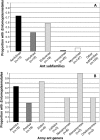Army ants harbor a host-specific clade of Entomoplasmatales bacteria
- PMID: 21075876
- PMCID: PMC3019723
- DOI: 10.1128/AEM.01896-10
Army ants harbor a host-specific clade of Entomoplasmatales bacteria
Abstract
In this article, we describe the distributions of Entomoplasmatales bacteria across the ants, identifying a novel lineage of gut bacteria that is unique to the army ants. While our findings indicate that the Entomoplasmatales are not essential for growth or development, molecular analyses suggest that this relationship is host specific and potentially ancient. The documented trends add to a growing body of literature that hints at a diversity of undiscovered associations between ants and bacterial symbionts.
Figures


Similar articles
-
The structured diversity of specialized gut symbionts of the New World army ants.Mol Ecol. 2017 Jul;26(14):3808-3825. doi: 10.1111/mec.14140. Epub 2017 May 12. Mol Ecol. 2017. PMID: 28393425
-
The gut bacterial communities associated with lab-raised and field-collected ants of Camponotus fragilis (Formicidae: Formicinae).Curr Microbiol. 2014 Sep;69(3):292-302. doi: 10.1007/s00284-014-0586-8. Epub 2014 Apr 20. Curr Microbiol. 2014. PMID: 24748441
-
Surveying the microbiome of ants: comparing 454 pyrosequencing with traditional methods to uncover bacterial diversity.Appl Environ Microbiol. 2013 Jan;79(2):525-34. doi: 10.1128/AEM.03107-12. Epub 2012 Nov 2. Appl Environ Microbiol. 2013. PMID: 23124239 Free PMC article.
-
Deep divergence and rapid evolutionary rates in gut-associated Acetobacteraceae of ants.BMC Microbiol. 2016 Jul 11;16(1):140. doi: 10.1186/s12866-016-0721-8. BMC Microbiol. 2016. PMID: 27400652 Free PMC article.
-
Gut bacteria associated with different diets in reared Nephrops norvegicus.Syst Appl Microbiol. 2012 Oct;35(7):473-82. doi: 10.1016/j.syapm.2012.07.004. Epub 2012 Oct 4. Syst Appl Microbiol. 2012. PMID: 23040460
Cited by
-
Microbiomes of ant castes implicate new microbial roles in the fungus-growing ant Trachymyrmex septentrionalis.Sci Rep. 2011;1:204. doi: 10.1038/srep00204. Epub 2011 Dec 22. Sci Rep. 2011. PMID: 22355719 Free PMC article.
-
First insight into microbiome profile of fungivorous thrips Hoplothrips carpathicus (Insecta: Thysanoptera) at different developmental stages: molecular evidence of Wolbachia endosymbiosis.Sci Rep. 2018 Sep 26;8(1):14376. doi: 10.1038/s41598-018-32747-x. Sci Rep. 2018. PMID: 30258200 Free PMC article.
-
The evolution of abdominal microbiomes in fungus-growing ants.Mol Ecol. 2019 Feb;28(4):879-899. doi: 10.1111/mec.14931. Epub 2018 Dec 10. Mol Ecol. 2019. PMID: 30411820 Free PMC article.
-
A metatranscriptomic approach to the identification of microbiota associated with the ant Formica exsecta.PLoS One. 2013 Nov 18;8(11):e79777. doi: 10.1371/journal.pone.0079777. eCollection 2013. PLoS One. 2013. PMID: 24260298 Free PMC article.
-
Development but not diet alters microbial communities in the Neotropical arboreal trap jaw ant Daceton armigerum: an exploratory study.Sci Rep. 2020 Apr 30;10(1):7350. doi: 10.1038/s41598-020-64393-7. Sci Rep. 2020. PMID: 32355187 Free PMC article.
References
-
- Blüthgen, N., G. Gebauer, and K. Fiedler. 2003. Disentangling a rainforest food web using stable isotopes: dietary diversity in a species-rich ant community. Oecologia 137:426-435. - PubMed
-
- Clark, T. B. 1984. Diversity of Spiroplasma host-parasite relationships. Isr. J. Med. Sci. 20:995-997. - PubMed
Publication types
MeSH terms
Substances
LinkOut - more resources
Full Text Sources
Molecular Biology Databases

